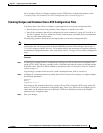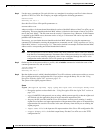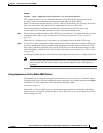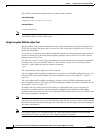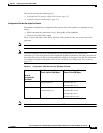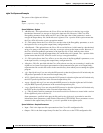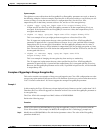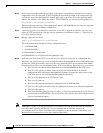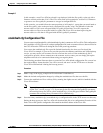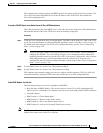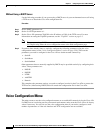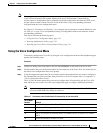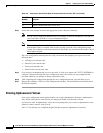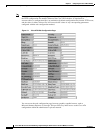
3-17
Cisco ATA 186 and Cisco ATA 188 Analog Telephone Adaptor Administrator’s Guide for MGCP (version 3.0)
OL-4803-01
Chapter 3 Configuring the Cisco ATA for MGCP
Configuring the Cisco ATA Using a TFTP Server
Example 2
In this example, a new Cisco ATA has already b een deployed (with the EncryptKey value set) with a
firmware version earlier than 2.16.2. The Cisco ATA needs to be upgraded to version 2.16.2 firmware
or greater to use EncryptKeyEx parameter to encrypt its configuration file.
In this scenario, you would follow the same procedure as in Example 1, except that you would need to
set the EncryptKey value to the previously configured EncryptKey value. The difference is that the
ata<macaddress> file is now encrypted with EncryptKey because the Cisco ATA expects the
ata<macaddress> file to be encrypted with EncryptKey.The Cisco ATA can then begin using the
ata<macaddress>.x file that is encrypted with the EncryptKeyEx parameter.
atadefault.cfg Configuration File
You can create a configuration file, called atadefault.cfg, that is common to all Cisco ATAs. This configuration
file is applied to a Cisco ATA only if a unique configuration file (such as ata<macaddress>) does not exist for
the Cisco ATA on the TFTP server during the Cisco ATA power-up procedure.
You can use the atadefault.cfg file to provide limited functionality for when you first install the
Cisco ATA. For example, if your service provider provides the ethernet connection and VoIP telephony
service, you may need to call customer service to activate the service. If the atadefault.cfg file is
configured to provide a direct connection to the customer service center, you can simply pick up the
telephone and wait to be connected without using your regular phone.
The following procedure illustrates how to create the Cisco ATA default configuration file, convert it to
the required binary format that the Cisco ATA can read, and store it on the TFTP server so that the
Cisco ATA will download it during the boot-up process:
Procedure
Step 1 Make a copy of the mgcp_example.txt file and rename it atadefault.txt.
Step 2 Make the desired configuration changes by editing the atadefault.txt file, then save the file.
Step 3 Convert the atadefault.txt file to a binary file by running the cfgfmt.exe tool, which is bundled with the
Cisco ATA software.
Note If you wish to encrypt the binary file for security reasons, see the “Using Encryption With the
cfgfmt Tool” section on page 3-12. If you encrypt the file using the EncryptKeyEx parameter,
the resulting binary file will be called atadefault.cfg.x; if not encrypted with the EncryptKeyEx
parameter the resulting binary file name will be atadefault.cfg.
Step 4 Store the binary atadefault.cfg (or atadefault.cfg.x) configuration file in the TFTP server root directory.
During the boot-up process, the Cisco ATA will download this file as its configuration file unless it first
finds a Cisco ATA-specific configuration file named for the MAC address of the Cisco ATA.



